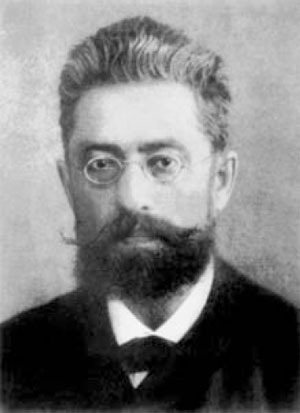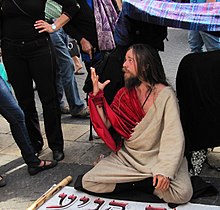Psychosis is a condition of the mind that results in difficulties determining what is real and what is not real. Symptoms may include delusions and hallucinations, among other features. Additional symptoms are incoherent speech and behavior that is inappropriate for a given situation. There may also be sleep problems, social withdrawal, lack of motivation, and difficulties carrying out daily activities. Psychosis can have serious adverse outcomes.
A delusion is a false fixed belief that is not amenable to change in light of conflicting evidence. As a pathology, it is distinct from a belief based on false or incomplete information, confabulation, dogma, illusion, hallucination, or some other misleading effects of perception, as individuals with those beliefs are able to change or readjust their beliefs upon reviewing the evidence. However:
Schizoaffective disorder is a mental disorder characterized by abnormal thought processes and an unstable mood. This diagnosis requires symptoms of both schizophrenia and a mood disorder: either bipolar disorder or depression. The main criterion is the presence of psychotic symptoms for at least two weeks without any mood symptoms. Schizoaffective disorder can often be misdiagnosed when the correct diagnosis may be psychotic depression, bipolar I disorder, schizophreniform disorder, or schizophrenia. This is a problem as treatment and prognosis differ greatly for most of these diagnoses. many people with schizoaffective disorder have other mental disorder including anxiety disorders
Richard Bentall is a Professor of Clinical Psychology at the University of Sheffield in the UK.
Stimulant psychosis is a mental disorder characterized by psychotic symptoms. It involves and typically occurs following an overdose or several day binge on psychostimulants; however, one study reported occurrences at regularly prescribed doses in approximately 0.1% of individuals within the first several weeks after starting amphetamine or methylphenidate therapy. Methamphetamine psychosis, or long-term effects of stimulant use in the brain, depend upon genetics and may persist for some time.
Ganser syndrome is a rare dissociative disorder characterized by nonsensical or wrong answers to questions and other dissociative symptoms such as fugue, amnesia or conversion disorder, often with visual pseudohallucinations and a decreased state of consciousness. The syndrome has also been called nonsense syndrome, balderdash syndrome, syndrome of approximate answers, hysterical pseudodementia or prison psychosis.

Emergency psychiatry is the clinical application of psychiatry in emergency settings. Conditions requiring psychiatric interventions may include attempted suicide, substance abuse, depression, psychosis, violence or other rapid changes in behavior.

Paris syndrome is a cluster of psychiatric symptoms exhibited by some individuals when visiting Paris, that can be viewed as a severe form of culture shock.

Victor Khrisanfovich Kandinsky was a Russian Empire psychiatrist, and was 2nd cousin to famed artist Wassily Kandinsky. He was born in Siberia into a large family of extremely wealthy businessmen. Victor Kandinsky was one of the famous figures in Russian psychiatry and most notable for his contributions to the understanding of hallucinations.

Grandiose delusions (GDs), also known as delusions of grandeur or expansive delusions, are a subtype of delusion characterized by extraordinary belief that one is famous, omnipotent, wealthy, or otherwise very powerful. Grandiose delusions often have a religious, science fictional, or supernatural theme. Examples include the extraordinary belief that one is a deity or celebrity, or that one possesses extraordinary talents, accomplishments, or superpowers.
Brief psychotic disorder—according to the classifications of mental disorders DSM-IV-TR and DSM-5—is a psychotic condition involving the sudden onset of at least one psychotic symptom lasting 1 day to 1 month, often accompanied by emotional turmoil. Remission of all symptoms is complete with patients returning to the previous level of functioning. It may follow a period of extreme stress including the loss of a loved one. Most patients with this condition under DSM-5 would be classified as having acute and transient psychotic disorders under ICD-10. Prior to DSM-IV, this condition was called "brief reactive psychosis." This condition may or may not be recurrent, and it should not be caused by another condition.

Postpartum psychosis (PPP), also known as puerperal psychosis or peripartum psychosis, involves the abrupt onset of psychotic symptoms shortly following childbirth, typically within two weeks of delivery but less than 4 weeks postpartum. PPP is a condition currently represented under "Brief Psychotic Disorder" in the Diagnostic and Statistical Manual of Mental Disorders, Volume V (DSM-V). Symptoms may include delusions, hallucinations, disorganized speech, and/or abnormal motor behavior. Other symptoms frequently associated with PPP include confusion, disorganized thought, severe difficulty sleeping, variations of mood disorders, as well as cognitive features such as consciousness that comes and goes or disorientation.
Mystical psychosis is a term coined by Arthur J. Deikman in the early 1970s to characterize first-person accounts of psychotic experiences that are strikingly similar to reports of mystical experiences.

Kfar Shaul Mental Health Center, established in 1951, is an Israeli public psychiatric hospital located between Givat Shaul and Har Nof, Jerusalem. It is affiliated with the Hadassah Medical Center and the Hebrew University of Jerusalem. The hospital is Jerusalem's designated psychiatric hospital for tourists who display mental health disturbances, and is widely known for its research on Jerusalem Syndrome.
Spiritual crisis is a form of identity crisis where an individual experiences drastic changes to their meaning system typically because of a spontaneous spiritual experience. A spiritual crisis may cause significant disruption in psychological, social, and occupational functioning. Among the spiritual experiences thought to lead to episodes of spiritual crisis or spiritual emergency are psychiatric complications related to existential crisis, mystical experience, near-death experiences, Kundalini syndrome, paranormal experiences, religious ecstasy, or other spiritual practices.
Substance-induced psychosis is a form of psychosis that is attributed to substance intoxication. It is a psychosis that results from the effects of chemicals or drugs. Various psychoactive substances have been implicated in causing or worsening psychosis in users.
Zouhuorumo, also known as qigong deviation, is a Chinese-culture concept traditionally used to indicate that something has gone wrong in spiritual or martial arts training. The qigong community uses this term to describe a physiological or psychological disorder believed to result during or after qigong practice, due to "improper practice" of qigong and other self-cultivation techniques. The concept was highlighted in the social and political context of mass popularization of qigong in China. The Buddhist or Taoist community also uses this term when referring to people who practice esoteric techniques or meditation without the proper guidance of a teacher.

A religious delusion is defined as a delusion, or fixed belief not amenable to change in light of conflicting evidence, involving religious themes or subject matter. Religious faith, meanwhile, is defined as a belief in a religious doctrine or higher power in the absence of evidence. Psychologists, scientists, and philosophers have debated the distinction between the two, which is subjective and cultural.
The relationship between religion and schizophrenia is of particular interest to psychiatrists because of the similarities between religious experiences and psychotic episodes. Religious experiences often involve reports of auditory and/or visual phenomena, which sounds seemingly similar to those with schizophrenia who also commonly report hallucinations and delusions. These symptoms may resemble the events found within a religious experience. However, the people who report these religious visual and audio hallucinations also claim to have not perceived them with their five senses, rather, they conclude these hallucinations were an entirely internal process. This differs from schizophrenia, where the person is unaware that their own thoughts or inner feelings are not happening outside of them. They report hearing, seeing, smelling, feeling, or tasting something that deludes them to believe it is real. They are unable to distinguish between reality and hallucinations because they experience these hallucinations with their bodily senses that leads them to perceive these events as happening outside of their mind. In general, religion has been found to have "both a protective and a risk increasing effect" for schizophrenia.
Bouffée délirante (BD) is an acute and transient psychotic disorder. It is a uniquely French psychiatric diagnostic term with a long history in France and various French speaking nations: Caribbean, e.g., Haiti, Guadeloupe, Antilles and Francophone Africa. The term BD was originally coined and described by Valentin Magnan (1835–1916), fell into relative disuse and was later revived by Henri Ey (1900–1977).







